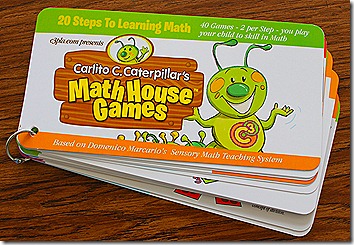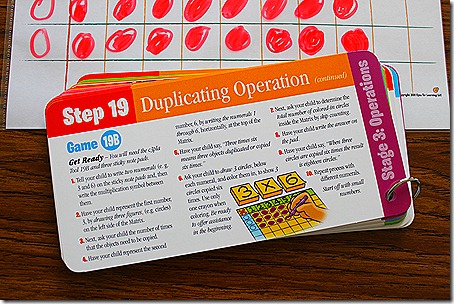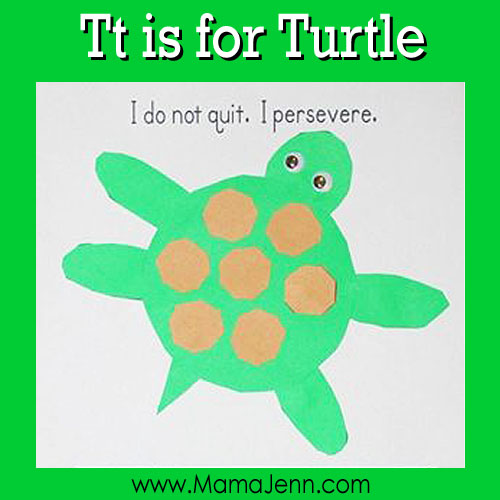As a former math teacher, I am always excited to check out new math materials! So, of course, I agreed to review the Carlito C. Caterpillar’s MathHouse Game Card Set.
So, what exactly is the game card set? Well, I must admit that it is not quite what I had expected. In fact, it is better. I thought it was going to be a single game. However, it is a set of 40 games with 20 steps (2 games per step). Designed to provide a chance for parents to teach their kids math skills through fun and games while building relationships at the same time, the games and steps are divided into three stages:
Stage 1: Quantity
|
“The 10 steps of Stage 1 immerse the learner in playful activities that enable a student to develop the necessary skills to imagine, to see, and to feel the numbers from 0 to 10, and, most importantly, to establish a strong math foundations.” |
Stage 2: Numeration
|
“How Ten becomes 10 is a milestone in the learning of math. The numeration of our system of numbers as a decimal system is done with the aid of an abacus. The use of this c3pla tool addresses the visual and tactile ways in which children learn. Skip Counting is also included in Stage 2 because it is a form of enumeration.” |
Stage 3: Operations
|
“If numbers are the materials of math, operations are the tools that utilize those materials. Operations are defined in the context of objects and actions with which children are familiar. Addition is simulated by gluing together two strips of graph paper. Subtraction is modeled by cutting them. Multiplication is taught by copying, duplicating. And Division is demonstrated by folding.” |
The set contains
- 30 double-sided, full color, illustrated Game Cards
- Related editorial information explaining to parents The What, Why and How of Each Step
- Each 8″ x 4″ loose leaf card is printed on heavy card stock, lacquered to help protect from spills and ring bound to keep together and facilitate play
I had fun playing some of the games from the set with my 4 year olds. In the photo below we are working on quantities of numbers from 0 to 10. We matched the symbol, word and quantity of each.
Below I used one of the techniques/games from the set with my 7 year old to visually reinforce the concept of multiplication by showing that it is multiple duplications. This activity helped to reinforce the repetitive addition behind multiplication.
Here is a close-up of the card (and instructions) that we used.
FYI, many of the games require materials that you could easily make for yourself. However, you can also download many of the need materials for free! Both of the printables shown in the above photos are free downloads from the site. I slid the second one in a clear page protector so that it could be re-used!
While we have not played all of the games, I am certain that I will be adding many of the other Carlito C. Caterpillar’s MathHouse games to my lesson plans. I love it when my kids have fun learning! It is even better when they are so busy “playing” and having fun that they don’t even realize that they are learning!
You can purchase your own set of Carlito C. Caterpillar’s MathHouse game cards for $23.95 (includes free s&h).
If you would like more info, be sure to head over to the Carlito C.Caterpillar website or follow Carlito C. Caterpillar MathHouse Games on Facebook!
Giveaway Info:
~Giveaway is Closed~
So, would you like to win a set of Carlito C. Caterpillar MathHouse Game Cards? I have the opportunity to give away a set to one of my readers! The first and mandatory entry is to leave a comment telling me one fun activity that you use to teach math to your child(ren) or students.
Optional (Additional) Entries: The following are additional ways that you can enter to win. However, you MUST complete the mandatory entry above. (Be sure to leave a separate comment for each entry!)
- Follow Mama Jenn via Google Friend Connect (see right sidebar on blog) AND/OR subscribe to Mama Jenn via RSS and/or via email and leave a comment letting me know that you do. Leave a comment for EACH follow or subscription. (max 3 entries)
- Check out the Tips for Shaping Learning and leave a comment telling me one of the tips that you use with your children. (max 1 entry)
- Check out the Myths and Realities of Early Mathematical Learning and leave a comment telling me one myth or reality that you agree or disagree with! (max 1 entry)
The giveaway ends at midnight on Friday, October 7th! Giveaway is for US residents only. Winners will be randomly selected and emailed. Be sure to leave a separate comment for each entry and a way for me to contact you in case you win!
Disclosure of Material Connection: I received one or more of the products or services mentioned above for free in the hope that I would mention it on my blog. Regardless, I only recommend products or services I use personally and believe will be good for my readers. I am disclosing this in accordance with the Federal Trade Commission’s 16 CFR, Part 255: “Guides Concerning Endorsements and Testimonials in Advertising.






 Crispy Rice Pumpkin Treats (Easy to Make Recipe for Kids)
Crispy Rice Pumpkin Treats (Easy to Make Recipe for Kids)
Semi-Crunchy Semi-Sane
Myth 6: Totally disagree as I’ve learned that my child seems to be VERY advanced in certain math areas and yet can’t grasp something that she “should” be able to understand. That doesn’t mean that she’s not good at math, it just means that she’s grasping one concept more easily than another.
Semi-Crunchy Semi-Sane
Fave tip: downplay failure and praise success!
Semi-Crunchy Semi-Sane
Follow you via GFC
Semi-Crunchy Semi-Sane
Subscribed via RSS
Semi-Crunchy Semi-Sane
Subscribed via RSS
Semi-Crunchy Semi-Sane
I do a lot of patterns and having my preschooler help me measure. I also sometimes double my recipes so that she can learn doubling too.
kristina
From Tips for Shaping Learing, one thing we do is use candy and/or food to help in learning a concept! It works!
kristina
I agree with reality number 1 that says children can learn math at any age… it isn’t too abstract for them. We shouldn’t “dumb” our children down… they are smarter than we sometimes give them credit for. “Whether young children are ready to learn particular concepts or skills depends largely on how supportive the educational as well as the home environment is. The more appropriate supports we provide to young children, the more ready they are to explore and learn.” So true!
kristina
Following via RSS!
Kristina
Just today we did math story problems with my son’s Monster Trucks and he was thrilled! We also play “War” with a deck of cards, addition/ subtraction swamp game, and I’ve incorporated odd/ even numbers into coloring our sight words. He loves it!
Kbalman
I agree with this being a myth: Early mathematical learning entails much factual knowledge and rote memory, such as naming numbers, counting up, and recognizing patterns. Such exercises have minimal value to the development of young children’s cognitive abilities. [email protected]
Kbalman
Our children do household chores like folding laundry and matching socks [email protected]
Kbalman
Subscribe via RSS feed to Mama Jenn [email protected]
Kbalman
Follow Mama Jenn via Google Friend Connect [email protected]
Kbalman
We use items like marbles, leaves, cicada shells to count with [email protected]
Jennifer N.
Also – I’m a subscriber to your blog through my Google Reader/RSS Feed.
Jennifer N.
Wow – these are great. My 5-year old is a games-learner. If he could play games all day, he would be in heaven. Thanks for sharing. I’m definitely going to have to look more closely at this.
Kala
I subscribe via email
Kala
My kids love M&M’s because they know if they do good they get to eat them 🙂
Tstremblay
We enjoy using the white board to illustrate math questions and my son loves to count the money in his piggybank.
jennbrill
fun activity that we use to teach math…we counters with flash cards to see the addition and subtraction, we play store, we go one number hunts…find 3 yellow whatever…combining concepts…
jennbrill
myth 5 struck me…we do a lot of verbalizing math with my daughters…and I think that they are learning and don’t even know it…cooking breakfast, lunch – cutting the sandwich into shapes and fractions…and just about everything else…
jennbrill
tips for shaping learning…i use almost all of them in some form or fashion…I try to make everything a learning opportunity. My daughter loves to go to the farmers market with me and “help” the farmer make change…I give her a 10 and she can use her fingers to work on addition and subtraction…and I get my veggies!!!
jennbrill
i suscribe to email updates
jennbrill
I suscribe for email updates
Christy
I agree with myth #5, and think that children can learn without manipulatives – but sometimes we need those manipulatives to grab their attention and help make it more enjoyable for them.
Christy
I do try to introduce concepts with situations that are relevant to my child. We often use their stuffed animals to act out addition and subtraction word problems.
Christy
I follow Mama Jenn by email subscription! Thanks! 🙂
Christine
I think I need to do a better job of making math fun! We do have a lot of math games, like sum swamp.
Carol
I totally DISAGREE with the myth that math “is primarily a non-verbal subject.” My special needs son has to always been verbal, so he talks about everything ~ even if I can’t figure out what he’s saying!
Carol
One “tip” I always use with my special needs son is to praise him for ANY success!
Carol
I follow Mama Jenn via e-mail ~
Carol
My little guy has Down Syndrome, and it’s been a challenge to get things to click with him. However, I use an occupational therapy gadget we made that works his fingers mucles to shoot cottonballs and pompoms ~ we practice counting the balls he can shoot into the air! Thanks for the giveaway!
Kelly
I subscribe via email.
Kelly
I follow you via RSS.
Kelly
I like using dice for my daughter to practice her adding. Thanks for the chance to win this.
laura
Myth/Reality 5 is good…using math talk, not just manipulatives to teach math.
laura
Letting my sons do the heavy work while I encourage, praise them are my 2 fave tips.
lauradodson
I subscribe via email!
Lisa
I am following you on Google FriendConnect.
Lisa
I agree with Reality #4, that kids need adult guidance in learning mathematical concepts.
Lisa
With math, we downplay failure and praise success
Lisa
I follow you via RSS and on Twitter and FB
Lisa
I am following you via email
Lisa
For a fun math activity, we do Dice Math. We roll 2 dice and add the sums.
Kori Ireland
Myth number 4 says direct instruction is unnecessary and their reality says it is. Could be a matter of semantics but I believe Young children don’t need direct instruction. I believe it can be “instructed” through play, games, rhymes, experiments and fun. They will get older and have plenty of direct instruction. Don’t start too soon! And talking to them in a fun way they understand for an explanation or question is not what I mean by direct instruction. To me direct instruction is sit down and listen while I give you a lesson.
Kori Ireland
From the Tips for Shaping Learning – Allow your child to develop his/her own way of solving a problem. I love this and LOVE that people have realized that not everyone must do everything exactly alike! And this concept is even taught in Singapore Math which is the curriculum we use. Sometimes we will take a problem and see how many ways we can solve it!
Kori Ireland
I subscribe by email!
Kori Ireland
Our current favorite math activity is using out education cubes! 🙂 We also like traditional store games and own a ton! Would love to add this math set to out shelves!
Wendi
I subscribe to Mama Jenn via email.
Wendi
I love living math books such as the M&M books and others.
Cooperkelly4
Craft time. Pasta noodles and beads can make easy lessons of patterns and sequences. Make a necklace for Grandma that uses a definite pattern. Model and explain as you make one, too, using words like “sequence,” “pattern,” and “every-other.”
love this idea for sharing learning tips.
Cooperkelly4
Myth 3:
Early mathematical learning entails much factual knowledge and rote memory, such as naming numbers, counting up, and recognizing patterns. Such exercises have minimal value to the development of young children’s cognitive abilities.
this is good to know that this is a myth! time for more math fun in our home!
Cooperkelly4
for teaching math, we have an app on my phone that rolls dice (you give the phone a little shake) the youngest looks at the numbers and writes them and the 2nd oldest says the numbers and adds them. For the 2 oldest we do math wrap ups.(not sure that is as fun for them, but it gets those math facts down)
Cooperkelly4
I follow via rss feed. =0)
Cherisek23
This would be such a great learning tool.
Tammyhuffaker
We really agree with this in our home:
Myth 2:
Early mathematics learning should focus primarily on number concepts, such as magnitudes (more or less), counting words, and enumeration because children hear number words in the everyday environment and acquire them naturally just like learning language.
Tammyhuffaker
Allow your child to develop his/her own way of solving a problem. Each method of problem solving reflects one’s individualistic style of thinking. Becoming self-reliant promotes growth and development as well as confidence and creativity.
We use this tip in our home!
Tammyhuffaker
I subscribe to Mama Jenn via e-mail.
Tammyhuffaker
We learn to count in our house by having to give Mommy a certain number of hugs or kisses. It’s big fun for everyone! Then, we move on to skip counting.
Heidi
Myth 6– disagree with the myth & agree with the reality wholeheartedly. One of the beauties of homeschooling is that ages and stages do not need to correspond to a predetermined progression… Each child is different and mine are really thriving with the freedom to take things at the pace that is just right for them.
Heidi
Tips for Shaping & Learning– I often use the “let the child do the heavy work” tip. We use Right Start A now with my 5yo and 4yo and the program has worked really well for my kids to get them doing the heavy lifting.
Heidi
I am an email subscriber.
Heidi
We are a couple months into Right Start A with my 5yo and 4yo and they love the games and abacus activities in that program.
Karyn
I already follow your blog.
Karyn
These sound great! We love math games. We do a lot with dice and dominoes at our house. Thanks for the giveaway.
Jess Patterson
I subscribe to Mama Jenn via RSS
Jess Patterson
We roll dice. We have many different kind of dice that are different shapes and thus go to many more numbers. So we will roll our dice with 20 sides and my boys will have to do that number of jumping jacks or touch your nose etc.
Beach Mama
I follow Mama Jenn via email.
Beach Mama
I follow Mama Jenn via RSS.
Trishbazin
we review all multiplication facts in a game that we adapted from a game called Bang. You pull a card with a problem on it if you get it right you keep the card, if you pull Band you put them all back….who ever has the most at the end wins. trishbazin(at)yahoo.com
Beach Mama
We use dice and counting cubes and make up games.
Susan
On the math myths, I whole heartedly agree that #4 is truly a myth–kids will NOT pick up naturally all the math concepts they need to know, even though they learn so much through their own play and discovery. That would be like expecting them to keep reinventing the wheel!
Susan
I do try and find math problems that my daughter can relate to. I will have her add up how much her swimming lessons cost, and then what if she was doing swimming lessons as well as gymnastic lessons as well.
Susan
I follow by e-mail as well.
Susan
I already follow your site! 🙂
Susan
I like to gather up some empty canning jars, and fill them with all sorts of things. Deflated balloons, crayons, cotton balls, marbles, whatever I can find that is different. Then I have my daughter estimate how many items are in each jar, afterwards she counts them and while counting will group by tens, fives, etc. I think this has been her favorite math activity so far!
Would so love to win this!
Michelle Massung
I connected via Google Friend Connect and “liked” you on FB!
Michelle Massung
My boys love to write on our sliding deck door with window markers, so my oldest (6) thinks it’s a fun game to practice math while writing on the window. Addition, subtraction, greater than-less than.